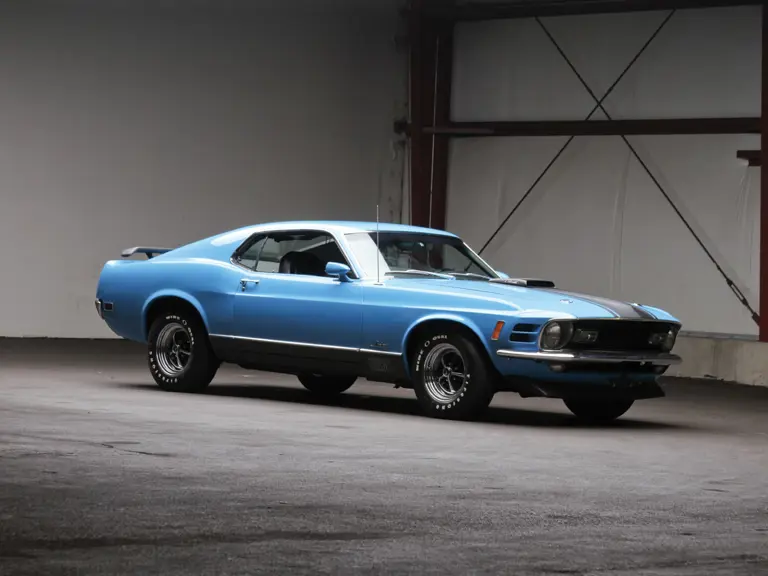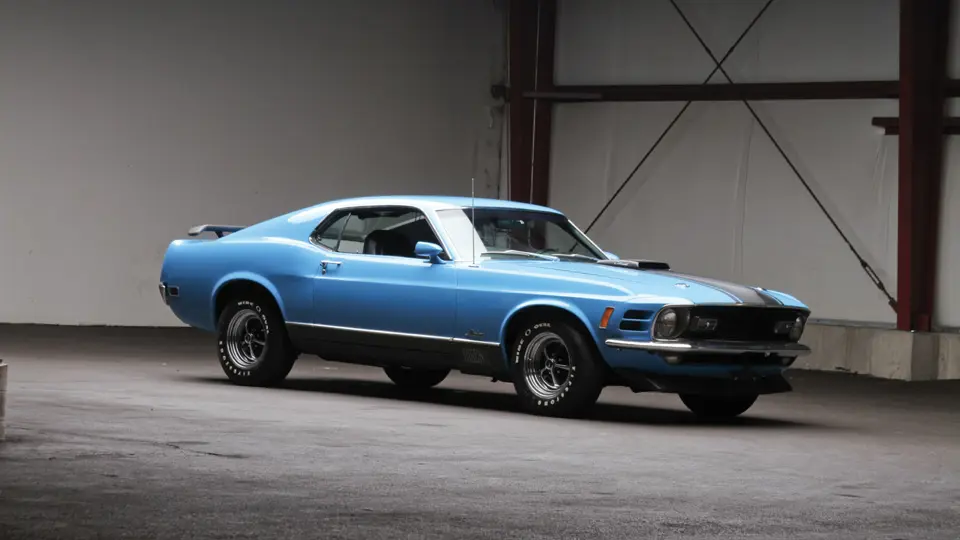 | Auburn, Indiana
| Auburn, Indiana
Introduced in 1964, the Mustang created a sensation in the media and in Ford showrooms across the country. It offered a winning combination of sporty performance, personal luxury, and fresh styling that turned out to be a direct hit on a previously unknown market segment. The result was the most successful new car introduction in the history of the automobile industry.
Ford’s Mustang triggered competition from every major car company, creating overnight the “pony car” class. Part of Mustang’s appeal – in addition to its lean size and sparkling performance – was the broad options list.
A buyer could specify anything from a spartan six-cylinder coupe to a top-of-the-line fully equipped V-8 convertible. In the late Sixties it seemed like horsepower would keep growing forever. Racing was on every manufacturer’s agenda and promoting the brand through performance was a way of life in Detroit; possibly no manufacturer did it on a bigger international stage than Ford Motor Company due to their participation and winning at LeMans and other races of the FIA World Sportscar Championship, Formula One by financing the soon-to-become-legendary Ford Cosworth DFV engine, and continued pursuit of victories in the USAC National Championship and its premier event, the Indianapolis 500.
Ford ceased its official racing activities in 1970, but not before they won the Trans Am title in a Bud Moore-prepared Mustang Boss 302 that was driven by teammates Parnelli Jones and George Follmer. The Mach 1 also was triumphant in the SCCA Manufacturer’s Rally Championship. This showed the great versatility of the Mustang Mach 1 platform in that it ran over 8,000 total rallying miles on all kinds of roads in all kinds of weather and finish every grueling stage with split-second precision. In real world terms, it had to have sprint-like acceleration, holding a tight line when cornering, brakes that won’t fade and have the power to ram your way through clogged mountain passes. The Mach 1 won these rallys because of mechanical attributes that includes a balanced wide-track chassis, sports car suspension design with front and rear stabilizer bars, heavy-duty springs and shocks, plus wide-rim wheels.
Today, the 1969-1970 Mustangs are one of hottest market segments. With eye-catching examples like the Mach 1 offered here, it is easy to see why, especially the fact that this is one of the special cars that received the rare Super Cobra Jet engines. The R-code 428 SCJ was first presented during the 1969 model year. Mustang customers who selected either of the optional 3.91:1 or 4.30:1 rear end gear ratios got more than an optional axle feature. Ordering either of these axle ratio options commonly prompted a few other upgrades as well, including the 428 Super Cobra Jet engine, an external oil cooler located in front of the radiator, and relocation of the driver's side horn to the passenger side of the radiator core support to make room for the oil cooler. Beginning in February 1969 this complete package could be ordered as the "Drag Pack" option with the modified 428 cubic inch Super Cobra Jet engine. It is reported that the basic strength of the Super Cobra Jet engine is in a more durable assembly of the crank, rods, pistons, flywheel/flexplate and harmonic balancer. This redesign was calculated to withstand the higher RPM requisites of drag racing.
Show quality is an understatement when describing this rotisserie restored SCJ Mach 1. It is finished in the exciting period color of Grabber Blue and comes with a black interior; it is picture perfect in its handsome presentation. From the proper primer finish on the undercarriage to the highly-detailed engine compartment with smog equipment and hose clamps, stickers and chalk marks all in the right places, it is hardly possible to fault the outstanding appearance.
This Mustang was delivered from the factory as a 428 cubic inch Ram Air Super Cobra Jet Mach 1 rated at 335 horsepower. Among the many additional features that came with this exceptional car is the sought-after console-mounted four-speed manual transmission. Many consider this to be the source of the “magic” that comes with driving a musclecar such as this. Additional features are found with power steering, no power brakes, AM/FM system and Magnum 500 wheels shod with Firestone Wide O Oval tires. The front end design displayed a bold new grille, grille-mounted lamps, sport hood latches, “shaker” hood and a new black hood treatment. You will also see dual color-keyed racing mirrors, integral rear deck spoiler and front chin spoiler.
Inside, there are many extra niceties that include woodgrain applique on the console, dash and door panels, high-back bucket seats, Sport Deck rear seat, factory radio and a deluxe three-spoke Rim-Blow steering wheel. The driver’s side mirror also has remote adjustment. The exceptional restoration also includes excellent chrome and trim, and laser-straight body panels with well-aligned gaps. Nothing was left to want on this marvelous musclecar.





